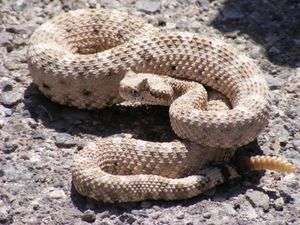Crotaline envenomation
Background
- The Crotalinae subfamily of Viperidae classifies the new world vipers, or pit vipers. The snakes have a pitlike depression behind the nostril that contains a heat-sensing organ used to find prey.
- Includes rattlesnakes and copperheads
- Venom causes local tissue injury, coagulopathy,and thrombocytopenia
- Up to 25% of bites are dry bites
Common Crotaline (Pit Viper) snake names
- Rattlesnake
- Cottonmouth
- Copperhead
- Sidewinder
- Water moccasin
- Massasauga
Venom
- Venom form a Crotaline mainly damages local tissue via metalloproteinases and hyaluronidase which cause swelling edema and damage to capillaries.
- Clinical effects consist of:
- Local tissue damage
- Coagulopathies (pro and anti effects)
- Platelet dysfunction
- Neurotoxic effects
Clinical Features
- Fang marks, localized pain, progressive edema extending from bite site
- Nausea/vomiting
- Oral numbness/tingling
- Dizziness
- Muscle fasciculations
- Ecchymoses may appear within minutes to hours
Differential Diagnosis
Envenomations, bites and stings
- Hymenoptera stings (bees, wasps, ants)
- Mammalian bites
- Closed fist infection (Fight bite)
- Marine toxins and envenomations
- Toxins (ciguatera, neurotoxic shellfish poisoning, paralytic shellfish poisoning, scombroid, tetrodotoxin
- Stingers (stingray injury
- Venomous fish (catfish, zebrafish, scorpion fish, stonefish, cone shells, lionfish, sea urchins)
- Nematocysts (coral reef, fire coral, box jellyfish, sea wasp, portuguese man-of-war, sea anemones)
- Phylum porifera (sponges)
- Bites (alligator/crocodile, octopus, shark)
- Scorpion envenomation
- Snake bites
- Spider bites
Evaluation
Work-Up
- CBC
- Coags
- Fibrinogen
- Chemistry
Evaluation
- Local injury (pain, progressive swelling, compartment syndrome, lymphangitic spread with pain in the axillae for upper extremity bites or pain in the inguinal region for lower extremity)
- Hematologic abnormality (thrombocytopenia, prolonged PT, hypofibrinogenemia) - DIC-like syndrome
- Systemic effects (hypotension resulting from third spacing)
Management
Local Care
- Do:
- Immobilize limb in a neutral position
- Remove all jewelry
- Mark the leading edge of erythema/edema
- Do not:
- Attempt to suck out the venom
- Place the affected part in cold water
- Use a tourniquet or wrap
- Antivenom is first line treatment for compartment syndrome; fasciotomy is last resort if elevated pressures persist.
Crofab administration
- See below
Supportive care
- IVF and vasopressors if needed for hypotension
- Blood products rarely needed
Crotalidae Polyvalent Immune Fab (FabAV) Antivenin (Crofab)
Indications
The following are criteria for administration after Crotalidae bite [3]
- Progression of swelling
- Abnormal results on lab tests (platelet < 100,000 or fibrinogen < 100)
- Systemic manifestations (unstable vitals or altered mental status)
Initial Administration
- Initial dose: 6 vials[1]
- Typically diluted into 250 cc or 1 L of normal saline and infused over an hour
- Same dose for both adults and pediatrics (may have to adjust the dilution of CroFab for small children so that they are not volume overloaded)
Maintenance therapy
- May repeat dose (2 vials) at 6, 12, and 18 hours later if symptoms not controlled[2]
- Maintance therapy may be indicated after initial dosing based on local protocols even if control is achieved.[3]
Envenomation control measurement
- Observe for progression of envenomation during and after antivenom infusion
- Measure limb circumference at several sites above and below bite
- Mark advancing border of edema q30min
- Repeat labs q4hr or after each course of antivenom (whichever is more frequent)
Side Effects
- Acute allergic reactions occur in <10% pts
- If occurs stop infusion and give epinephrine/antihistamines if needed
- Recurrent thrombocytopenia has been described up to 2 weeks after transfusion with FabAV and is likely a result of isolated renal clearance of FabAV and persistent presence of actual venom in serum.[4]
- Warrants close monitoring of platelets by primary physician or return visit after discharge
- Serum sickness is unlikely but precautions should be given to patents upon discharge
Disposition
- Observe all snakebite patients for at least 6hr before determining patient disposition
- Bites that initially appear innocuous and labs normal at presentation can be deceptive
- Discharge if symptom-free after 6hr
- Admit all patients receiving antivenom to the ICU
References
- Gerardo CJ. The efficacy of crotalidea polyvalent immune fab (ovine) antivenom versus placebo plus optional rescue therapy on recovery from copperhead snake envenomation: A randomized, double-blind, placebo-controlled, clinical trial. Annals of EM. August 2017. 70(2):233-244.
- Gerardo CJ. The efficacy of crotalidea polyvalent immune fab (ovine) antivenom versus placebo plus optional rescue therapy on recovery from copperhead snake envenomation: A randomized, double-blind, placebo-controlled, clinical trial. Annals of EM. August 2017. 70(2):233-244.
- Crofab treatment agorithmn http://www.crofab.com/documents/CroFab-Treatment_Algorithm.pdf
- Ruha AM et al. Late hematologic toxicity following treatment of rattlesnake envenomation with crotalidae polyvalent immune Fab antivenom. Toxicon. 2011;57:53–59.
This article is issued from
Wikem.
The text is licensed under Creative
Commons - Attribution - Sharealike.
Additional terms may apply for the media files.
